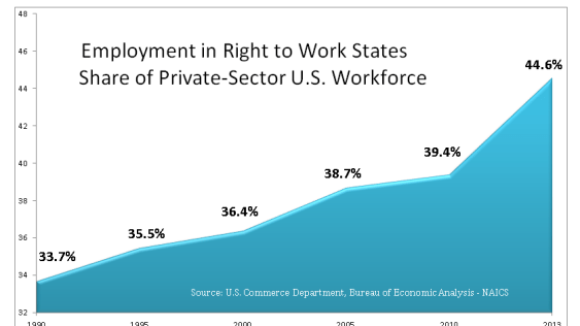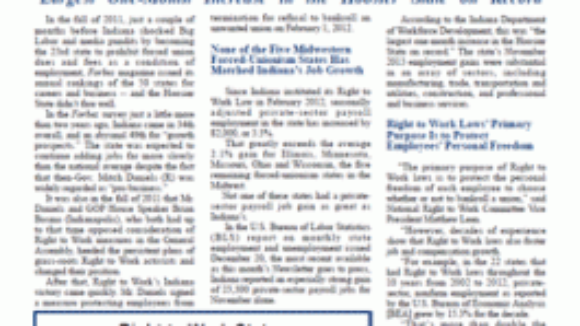Right to Work on State Legislators’ Agenda
Bans on Forced Union Dues Expected to Come up For Roll-Call Votes (Source: the January 2015 National Right to Work Committee Newsletter) With the vast majority of state legislatures across the…

Bans on Forced Union Dues Expected to Come up For Roll-Call Votes (Source: the January 2015 National Right to Work Committee Newsletter) With the vast majority of state legislatures across the…

According to the Indiana Department of Workforce Development, this was “the largest one-month increase in the Hoosier State on record.” The state’s November 2013 employment gains were substantial

At a hearing Monday afternoon on a pending Right to Work measure in Missouri, National Right to Work Newsletter editor Stan Greer, speaking in his capacity as senior research associate for the Committee’s affiliated think tank, explained to legislators…

Matt Mayer of the Buckeye Institute debunks the long-term economic growth without Right To Work freedom is sustainable. Mayer uses a Columbus Dispatch reporter Joe Hatlett column that featured Former Michigan Gov. Jennifer Granholm to expose the fact that corporate welfare and reduced regulations ignore the “proverbial elephant in the room weighing down” compulsory union states like Indiana, Ohio, Illinois,, and Michigan. From Matt Mayer’s post: “With Michigan bleeding jobs and tax revenues, Granholm said she followed the corporate playbook in her attempt to close a huge state budget deficit and make Michigan more competitive. ‘In listening to the business community, I cut takes [sic] 99 times, and I ended shrinking government more than any state in the nation. In my two terms, I cut more by far than any state in the nation. And yet, we still have the highest unemployment rate. There was no correlation.’ Granholm conceded that streamlining business regulations and lowering taxes — Kasich’s economic recovery mantra — are helpful, but they aren’t a panacea…[l]abor costs, help with start-up costs and proximity to markets are other factors.” Hallett and Governor Granholm fail to mention why streamlining regulations and lowering taxes aren’t helping the northern states (located within 50 percent of the U.S. population and with low start-up costs) compete against the southern and western states. Instead, Hallett ignores the obvious answer and pleads for an end to corporate pork (with which we enthusiastically agree). The reason Michigan and Ohio can’t compete is that the southern and western states already have fewer regulations and lower taxes, so “catching up” with those states still leaves the proverbial elephant in the room weighing down the northern states. Plus, those states are also pushing for lower taxes and fewer regulations, so the northern states are perpetually behind them. The elephant, which Governor Granholm does hint at, is labor costs, or, more specifically, unionized labor costs (see: General Motors and the United Auto Workers). As I noted in Six Principles for Fixing Ohio, “Of course, tax and regulatory burdens also impact a state’s economy. Although many of the forced unionization states have heavy tax burdens and many of the worker freedom states have light tax burdens, some heavily taxed worker freedom states (Idaho, Nevada, and Utah) had the strongest sustained job growth from 1990 to today. Similarly, a few moderately taxed forced unionization states still had weak job growth (Indiana, Illinois, and Missouri). The combination of both a heavy tax burden and forced unionization is deadly when it comes to job growth, as 11 of the 15 worst performing states are ranked in the top 20 for high tax burdens.” If Ohio and the other states from Missouri to Maine want to truly compete with Texas, Georgia, and South Carolina, then those states need to enact laws that protect the rights of workers not to join a labor union to get a job.

Matt Mayer of the Buckeye Institute debunks the long-term economic growth without Right To Work freedom is sustainable. Mayer uses a Columbus Dispatch reporter Joe Hatlett column that featured Former Michigan Gov. Jennifer Granholm to expose the fact that corporate welfare and reduced regulations ignore the “proverbial elephant in the room weighing down” compulsory union states like Indiana, Ohio, Illinois,, and Michigan. From Matt Mayer’s post: “With Michigan bleeding jobs and tax revenues, Granholm said she followed the corporate playbook in her attempt to close a huge state budget deficit and make Michigan more competitive. ‘In listening to the business community, I cut takes [sic] 99 times, and I ended shrinking government more than any state in the nation. In my two terms, I cut more by far than any state in the nation. And yet, we still have the highest unemployment rate. There was no correlation.’ Granholm conceded that streamlining business regulations and lowering taxes — Kasich’s economic recovery mantra — are helpful, but they aren’t a panacea…[l]abor costs, help with start-up costs and proximity to markets are other factors.” Hallett and Governor Granholm fail to mention why streamlining regulations and lowering taxes aren’t helping the northern states (located within 50 percent of the U.S. population and with low start-up costs) compete against the southern and western states. Instead, Hallett ignores the obvious answer and pleads for an end to corporate pork (with which we enthusiastically agree). The reason Michigan and Ohio can’t compete is that the southern and western states already have fewer regulations and lower taxes, so “catching up” with those states still leaves the proverbial elephant in the room weighing down the northern states. Plus, those states are also pushing for lower taxes and fewer regulations, so the northern states are perpetually behind them. The elephant, which Governor Granholm does hint at, is labor costs, or, more specifically, unionized labor costs (see: General Motors and the United Auto Workers). As I noted in Six Principles for Fixing Ohio, “Of course, tax and regulatory burdens also impact a state’s economy. Although many of the forced unionization states have heavy tax burdens and many of the worker freedom states have light tax burdens, some heavily taxed worker freedom states (Idaho, Nevada, and Utah) had the strongest sustained job growth from 1990 to today. Similarly, a few moderately taxed forced unionization states still had weak job growth (Indiana, Illinois, and Missouri). The combination of both a heavy tax burden and forced unionization is deadly when it comes to job growth, as 11 of the 15 worst performing states are ranked in the top 20 for high tax burdens.” If Ohio and the other states from Missouri to Maine want to truly compete with Texas, Georgia, and South Carolina, then those states need to enact laws that protect the rights of workers not to join a labor union to get a job.

From Missouri State Sen. Robert N. Mayer's Op-Ed in the Southeast Missiourian 'Right to work' equals jobs: More than 280,000 Missourians are out of work. The alarm is sounding and we should all hear the wake-up call that now is the time to put all the pieces in place so Missouri can truly compete for jobs. Currently, Missouri is missing out on new jobs because companies are drawn to other states with better worker protection laws. Fifty percent of manufacturers refuse to consider Missouri as a place to locate new jobs because we have no protections against forced unionization of our workers -- that's according to testimony given to the Senate General Laws Committee by Mark Sweeney. Sweeney is a site location consultant who works to find new plant sites for both domestic and foreign manufacturing companies. He says Missouri is off the radar for 50 percent of his clients, plus the rest consider right-to-work laws when weighing which state they will choose. Not having right-to-work has cost us in many ways. First, Missouri is losing a congressional seat due to the most recent census data. That data shows businesses with jobs and the workers who take them are fleeing to states with worker protection laws. Non-right-to-work states lost a total of nine congressional seats and, due to population shifts, right-to-work states gained 11. This session we have the opportunity to correct this wrong by bringing beneficial jobs to Missouri while keeping hard-working citizens in our state. Second, we have underperformed compared with the six of our eight neighboring states that are right-to-work states. All those states have lower unemployment rates than Missouri. Tennessee, the only one with a comparable rate to ours, gained jobs in 2010 while Missouri lost jobs. Plus, data from the U.S. Bureau of Labor Statistics shows unemployment is lower in the 22 states that have adopted right-to-work laws. In the last decade, those states have added 1.5 million private sector jobs, while non-right-to-work states have lost 1.8 million jobs. With more than 160,000 jobs lost in our state since June 2008, we cannot afford to stand by and not take action.
Former Missouri state treasurer and candidate for U.S. Senate Sarah Steelman says Right to Work “always works better than coercion” (Joplin Globe): The statistics are clear: Kansas is winning the battle of economic opportunity. Data from the Bureau of Labor…

Click image to contact Gov. Daniels. GOP Senate candidate in Missouri Sarah Steelman (R) joined a growing group of conservatives to to announce support of ‘Right to Work’ legislation in Missouri. “The first step that Missouri has to take to regain its competitive advantage…

KTTS reports that Missouri is moving forward in the effort to protect workers and create jobs by enacting a Right to Work law. Mayer says that unemployment is lower in the 22 Right to Work states than it is in…